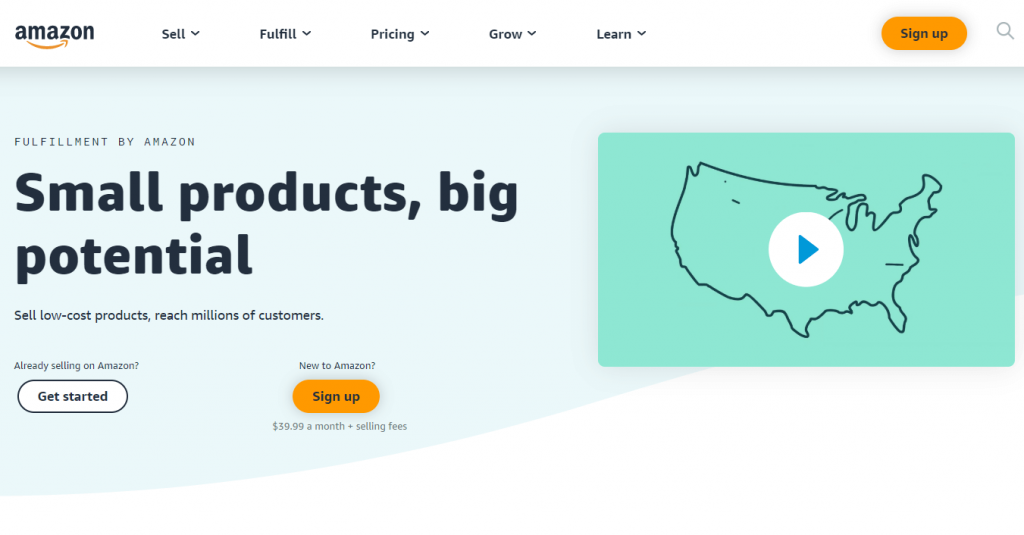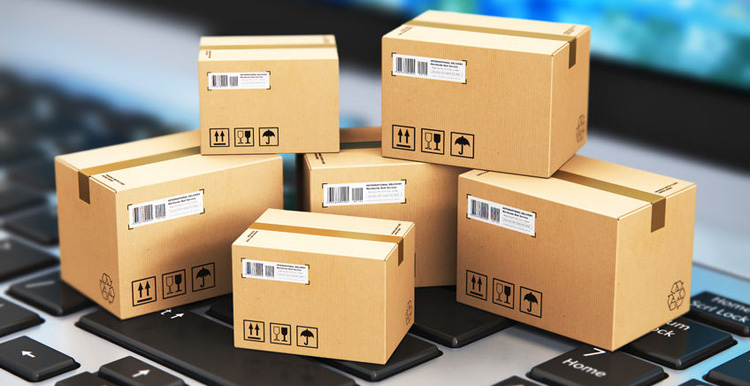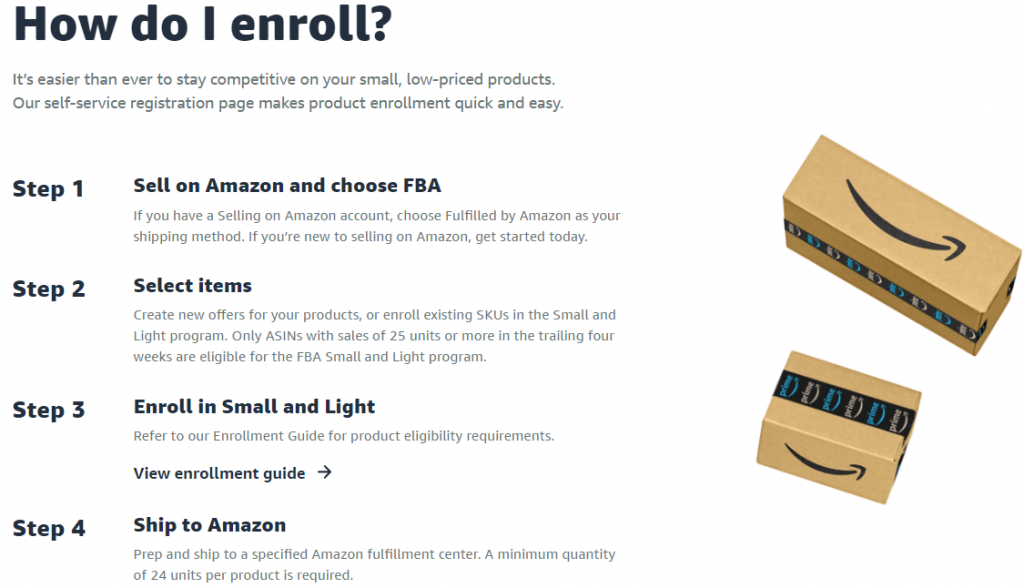As an Amazon seller, your main goal is to maximize profits and grow your business. And you probably know by now that joining the FBA program if your goods have a low price point doesn’t make too much sense.
What maybe you don’t know is that Amazon has an FBA program dedicated to the small, light, and inexpensive products.
It’s called FBA Small and Light and comes as a great solution for those who want to take advantage of the FBA benefits without losing a good share of their profits.
In this article, we’re going to tell you what are its benefits, how to adhere, and how to make the most out of it.
-
Quick Guide:
- 1. What is FBA Small and Light? What Are the Advantages?
- 2. FBA Small and Light Fees
- 3. FBA Small and Light VS Standard FBA
- 4. What are Amazon FBA Small and Light Requirements?
- 5. Small and Light Packaging Guide
- 6. Is It Worth It? What Are the Downsides?
- 7. How to Enroll in Amazon FBA Small and Light?
- Conclusion
1. What is FBA Small and Light? What Are the Advantages?

According to Amazon, FBA Small and Light is fulfillment by Amazon option for products with a price point below $15, a weight under 15 ounces and small enough to fit in a maximum package size of 16 x 9 x 4 inches.
The main advantage of this program is the reduced fulfillment cost if you’re opting for FBA.
Enrolling in this program comes with a host of additional benefits which include:
- Orders handled by Amazon: Just like the regular FBA, the Small and Light program involves fulfillment and return handled by Amazon, which ultimately means less hard work on your side.
- Competitive shipping rates: Through this program, you’ll benefit from the competitive inbound shipping rates offered by Amazon.
- Better customer service: Since the order is handled by Amazon, your clients will get free shipping. Orders are typically fulfilled in 4 to 8 days for both Prime and non-Prime shoppers.
- Opportunity to increase your client base: Since non-Prime customers benefit from the same shipping advantages as the Prime ones, you may gain some new clients who may not have bought your FBA products otherwise.
- You can use Small and Light, standard FBA, and self-fulfillment at the same time: You can make your products available to a wider customer base and maximize sales by using both standard FBA and Small and Light fulfillment. Just remember that the two will require separate inbounding processes. Furthermore, you can also opt for self-fulfillment for the same products if you run out of stock in the Amazon warehouse.
2. FBA Small and Light Fees
Undoubtedly, the lower fees are the main advantage of Small and Light. How much you will have to pay, however, depends on how much your product costs.
The program has separate order handling fees for products of $5 or under and products that cost over $5.
However, the pick & pack and the weight handling fees are the same for all products in the program, as highlighted in the table below.
| Fee Type | Small and Light Fee |
| Order handling (products $5 or under) | $0.80/order |
| Order handling (products over $5) | $1.00/order |
| Pick & Pack | $0.75/unit |
| Weight handling | $0.11/oz. rounded up to the nearest oz. |
A few important things to know is that weight handling refers to the total shipping weight, including the weight of both the product and the packaging.
Regarding the packaging weight, Amazon uses a standardized package weighing 0.7 oz., which will add up to the heft of your product.
You must also know that in case of mixed orders containing products from both price ranges, Amazon will automatically apply the higher fees to all products in that order.
If one or more products in the order have a sale price greater than $15, you will be charged standard FBA fees.
3. FBA Small and Light VS Standard FBA
The main difference between Small and Light and standard FBA is the lower fulfillment price you’ll get if you choose to adhere to the program.
In fact, Small and Light saves you $0.64 per order for products costing $5 or under and $0.22 for products costing over $5.
This could seem like little, but the savings add up quite quickly when you’re selling a lot.
For instance, for every 5 units sold in the first price threshold, you can save as much as $6.4.
If your products fall in the second fee range, you’ll still save $4.55 for every 5 units. Multiply by 100, and you’ll get a quite good share of extra profit.
Another great difference is that Amazon typically runs discounts on products priced $5 or under in the Consumables category and that enjoy popularity among consumers.
Amazon covers the discount costs, which means you’ll still get the same profit but also the possibility to gain more clients.
Small and Light sales are treated and processed as standard FBA, so you’ll get paid according to the same rules.
4. What are Amazon FBA Small and Light Requirements?
To join the FBA Small and Light program, you must first join the standard FBA; your products must also meet certain criteria, and you will have to submit your ASINs for approval.
As a general rule, know that all rules that apply to standard FBA apply to Small and Light too.
Furthermore, this program comes with other specific requirements:
- Your products may not exceed 16 x 9 x 4 inches
- Each product can weigh 15 ounces or under
- Each product must have a retail cost of $15 or under
You must also check if the products you sell are eligible. In broad lines, no products in the Restricted and FBA prohibited categories can be enrolled in the program.
Besides these, the following categories are also incompatible with the FBA Small and Light:
- Adult products
- Temperature-sensitive products
- Used products
- Hazmat products
Another eligibility requirement refers to how long a specific product has been on Amazon and how many sales it registered in the trailing four weeks.
If your ASIN has been on Amazon for more than 90 days and has sold – or is expecting to sell in the upcoming four weeks – less than 25 units, it’s not eligible for FBA Small and Light.
5. Small and Light Packaging Guide

Besides the eligibility requirements mentioned above, Amazon also has specific requirements regarding the packaging.
You must follow the rules below to make sure your products won’t get rejected.
- Every shipment must contain a minimum of 24 units per ASIN
- You must bundle together all units belonging to an ASIN with a clear plastic bag or place them in a manufacturer’s pack
- You must label each same-ASIN bag with the total quantity of sellable units
- Each individual product must be labeled with a scannable UPC, EAN, or Amazon barcode
Under the general FBA rules, remember that your shipping boxes must not be larger than 25 inches on any side, and you can’t shop boxes heavier than 50 pounds.
Anyway, because FBA Small and Light is a program created for small and lightweight products, the marketplace allows you to ship multiple ASINs in one box, as long as the packaging for each ASIN and the general FBA requirements are met.
6. Is It Worth It? What Are the Downsides?
While FBA Small and Light comes as a great opportunity for sellers who wouldn’t consider joining FBA due to the low price of their products, the program has some downsides too.
Perhaps the biggest drawback is the lack of the Prime symbol on these offers.
The symbol is excluded because all shoppers who are buying a Small and Light product benefit from preferential free shipping regardless of their Prime status.
As a result, Prime members looking for a product in your category might not notice your offer.
Another downside related to the non-Prime status of your offer regards the Buy Box.
In fact, since you don’t sell a Prime item, you’ll have fewer chances of winning the box than a regular FBA seller.
Due to the specific shipping requirements, you must also factor in some extra work to bundle together and label your ASINs when preparing your packages.
7. How to Enroll in Amazon FBA Small and Light?
Amazon FBA Small and Light is available to all Amazon sellers, and you can decide to enroll a new, self-fulfilled, or FBA ASIN into the program.
Regardless of your circumstances, you should remember that you must follow all general FBA rules as well as the specific FBA Small and Light rules to be eligible.
Here is how to enroll.

Step 1: Enroll in the FBA
If you haven’t done so already from your Amazon Seller Central control panel.
Step 2: Decide what SKUs you want to enroll in the program.
You have the following ASIN options to enroll:
- New Amazon ASIN: Create a new MSKU and enroll your product in the FBA Small and Light.
- Self-fulfilled ASIN: You can either use an existing MSKU if you want to switch from self-fulfilled to FBA or create a new MSKU so you can switch from FBA to FBM in case you run out of stock with FBA.
- FBA ASIN: You can use an existing MSKU for non-commingled products if you don’t currently have an inventory in Amazon warehouses and if your MSKU is tracked with Amazon barcodes.
Amazon doesn’t accept commingled products into the Small and Light program.
If you already have an FBA ASIN that you wish to enroll, you will have to create a new self-fulfilled MSKU first, then enroll your product directly into Small and Light.
Step 3: From your Seller Central dashboard, input the package dimension and weight for each SKU you wish to enroll.
To do that, you can simply download the enrollment template offered by Amazon, update it, and upload it back onto the Small and Light enrollment page.
Step 4: Check the Review Status and History tab to check the status of your upload.
It may take up to 8 hours for your file to be processed, and you’ll be notified on this page of any errors you must correct.
Step 5: Once your SKUs have been approved, create your inbound shipments from the Manage Inventory page.
Remember to respect all preparation and shipping requirements, or your shipment may be rejected.
Amazon also recommends sending sufficient inventory to cover at least 60 days.
You should also switch on your replenishment alerts or use third-party services to keep track of your sales, so you can prevent running out of stock.
While you’re selling under the FBA Small and Light, it is also essential to maintain competitive prices if you want to get the best results.
Conclusion
FBA Small and Light is a great alternative to standard FBA for all sellers who sell lightweight, small and inexpensive products.
This program will not only reduce your FBA fees, but it’s also a great alternative to self-fulfillment.
It is developed to take all burdens off of you while maintaining your profits in a good range.
Thanks to regular promotions run by Amazon, you can also increase your customer base and enhance your brand awareness without actually losing any profits.
FBA Small and Light is also extremely flexible. You can choose to fulfill your orders under the standard FBA rules or self-fulfill them if you run out of stock in the Amazon warehouse without losing your Small and Light eligibility.
Whether small and inexpensive products are the core of your business or you’re just looking for a way to expand your offer, joining FBA Small and Light can be an economical and practical way to fulfill your orders in all peace of mind.
You May Also Like:
An In-Depth Guide to Join Amazon Frustration-Free Packaging
Amazon Long Term Storage Fees: 5 Tips FBA Sellers Should Never Miss
Your Newest Guide to Amazon FBA Fees in 2020
Ultimate Guide & Tips on How to Contact Amazon Seller Support
Best 10 Amazon Pricing Strategies That Sellers Should Know
